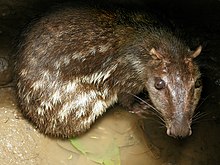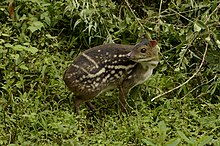User:JazGrabau/Forest ecology

Forest ecology article does contain a lot of relevant information, however is lacking some fundamental areas of content. Little is stated regarding the vast complex interactions between organisms, which is a vital aspect of forest ecology. Another aspect I found to be missing information is the distinct regions and layers that are found with in forest communities. Finally many of the facts lacked sources, and I had difficulty identifying what the specific sources where referring to, due to a lack of information provided in the citation.
How abiotic and biotic factors contribute to the greater ecosystem. There is a part that explains an experiment related to trees planted in a harsher environment versus a forest ecosystem. Both species struggled in the harsher environment, but the native species did worse being out competed by the invasive species that is originally from a harsher environment. They both faired better in the forest ecology, but the invasive species was still more abundant than the native species.[1]
| This is the sandbox page where you will draft your initial Wikipedia contribution.
If you're starting a new article, you can develop it here until it's ready to go live. If you're working on improvements to an existing article, copy only one section at a time of the article to this sandbox to work on, and be sure to use an edit summary linking to the article you copied from. Do not copy over the entire article. You can find additional instructions here. Remember to save your work regularly using the "Publish page" button. (It just means 'save'; it will still be in the sandbox.) You can add bold formatting to your additions to differentiate them from existing content. |
Article Draft[edit]

Forest ecology is the scientific study of the interrelated patterns, processes, flora, fauna and ecosystems in forests.[2] The management of forests is known as forestry, silviculture, and forest management. A forest ecosystem is a natural woodland unit consisting of all plants, animals, and micro-organisms (Biotic components) in that area functioning together with all of the non-living physical (abiotic) factors of the environment.[3]
Importance[edit]
Forests have an enormously important role to play in the global ecosystem. Forests produce approximately 28% of the Earth's oxygen (the vast majority being created by oceanic plankton),[4] they also serve as homes for millions of people, and billions depend on forests in some way. Likewise, a large proportion of the world's animal species live in forests. Forests are also used for economic purposes such as fuel and wood products. Forest ecology therefore has a great impact upon the whole biosphere and human activities that are sustained by it.
Types of Forests Ecosystems[edit]
Temperate Forests[edit]
Tropical Forests[edit]


Tropical forests are some of the most diverse ecosystems in the world.[5] Although there are many different tree species present per acre of forest, many share similar appearances due to the similar environmental pressures.[5][6] Some of these shared traits, possessed by many tropical trees, include thick and leathery leaves that are elongated and ovular with mid-ribs and drip-tips.[5][6] These adaptation help to quickly drain water from the leaves, likely to help prevent algae or lichen growth[5] and prevent water reflecting the sunlight or restricting transpiration.[6] Commonly, tropical trees have large buttress roots on larger trees, and stilt roots on mid-sized trees which help support their tall and vertical structures in the shallow and moist soil.[5][6] Tropical forests grow very densely due to the heavy rainfall and year-round growing season. This creates competition for light which causes many trees to grow very tall, blocking out most or all of the light from reaching the forest floor.[5] Because of this, the canopy exhibits distinct stratified layers from the tallest trees to the tightly packed midstory trees below.[5] Due to low light on the forest floor, there is a diverse population of epiphytes, a type of plant that grows on the canopy trees, rather than soil, to access better light. Many vines use a similar tactic, however they root in the ground, growing up the trees to reach light.[5] The fauna in tropical forests also show many unique adaptations to fill various niches. These adaptations are possessed by different species depending on where they are located.[5] For example, there are similar looking animals in the rainforests of South America and Africa that share ecological niches, however the mammals from South America are rodents while the African ones are ungulates. This clearly demonstrates the convergent evolution between species found in tropical forest environments.[5]
Coniferous Forests[edit]
Conifers have unique traits that make them especially adapted to harsh conditions, including cold, drought, wind, and snow.[6] Their leaves have a wax coating and are filled with resin to help prevent moisture loss, this makes them unpalatable to animals and slow to decompose. This leaf litter creates an acidic forest floor that is distinct to coniferous forests.[6] Because of the types of leaves possessed by conifers, they face the problem of soil nutrient loss; this problem is solved through mycorrhizal symbiosis with fungi that help transport the limited nutrients to the trees in exchange for sugars.[6] Some conifers are incapable of surviving without mycorrhizal fungi.[6] The majority of conifers are also evergreen, allowing them to take advantage of the short growing seasons of their respective environments.[6] Their thin tapered structure helps them to withstand strong winds without being blown over.[6] The stereotypically cone shape of conifers helps prevent large quantities of snow from building up on their branches and breaking them.[5] Due to the harsh environments that coniferous forest are commonly found, the diversity is limited in both plant and animal species. The colder climates limit the number of reptilian and amphibian species that can survive.[6] The species more commonly found in coniferous forests are mammals, including large herbivores such as moose and elk, predators like bears and wolves, along with a few smaller species like rabbits, foxes, and mink. There are also a variety of migratory bird species and some birds of prey such as owls and hawks.[6] Coniferous forest contain a variety valuable pulp and lumber trees making them some of the most economically important ecosystems.[6] They have also been historically sought for the fur trade due to the animals species that inhabit them.[6]
Island Forests[edit]
Ecological Interactions[edit]
Plant-Plant Interactions[edit]
In forests, trees and shrubs often serve as nurse plants that facilitate the establishment and seedling growth of understory plants. The forest canopy protects young understory plants from extremes of temperature and dry conditions.[7] In addition the species of tree that is predominate in the ecosystem helps determine the understory's environments by conserving water and limiting sun light.[8] The balance kept by canopy trees on the understory is shown when canopy gaps are formed due to disturbances. According to the study done by Joan Ehrenfeld on old growth oak forest canopy gaps, it was shown that the understory plant population density was much higher than that of undisturbed forest.[9]
Plant-Animal Interactions[edit]
Mycorrhizal Symbiosis[edit]

An important interaction in forest ecosystems is the mycorrhizal network, which consists of fungi and plants that share symbiotic relationships.[10] Mycorrhizal networks have been shown to increase the uptake of important nutrients, especially ones which disperse slowly into the soil like phosphorus.[11] The fine hypha of the mycelium is able to reach father into the soil than the roots of the plant, allowing it to better access phosphorus and water.[11] The mycorrhizal network can also transport water and nutrients between plants.[12] These interactions can help provide drought resistance to their symbiotic plants, helping protect them through the progression of climate change.[11] However, it's been shown that the benefit of mycorrhizal networks vary greatly depending on the species of plant and nutrient availability. The plants’ benefit from mycorrhizal fungus decreases as nutrient density increases, because the plants' loss of sugars costs more than the benefit they receive.[10] While many plants rely on mycorrhizal symbiosis, not all possess this ability, and those without are shown to be negatively affected by the presence of mycorrhizal fungi.[10]
References[edit]
- ^ Dunson, William A.; Travis, Joseph (1991). "The Role of Abiotic Factors in Community Organization". The American Naturalist. 138 (5): 1067–1091. ISSN 0003-0147.
- ^ Führer, Erwin (2000-06-15). "Forest functions, ecosystem stability and management". Forest Ecology and Management. 132 (1): 29–38. doi:10.1016/S0378-1127(00)00377-7. ISSN 0378-1127.
- ^ Robert W. Christopherson. 1996
- ^ "Save the Plankton, Breathe Freely". 28 February 2012.
- ^ a b c d e f g h i j k Ehrlich, Paul R.; Roughgarden, Joan (1987). The science of ecology. New York : London: Macmillan ; Collier Macmillan. ISBN 978-0-02-331700-2.
- ^ a b c d e f g h i j k l m n The International book of the forest. New York: Simon and Schuster. 1981. ISBN 978-0-671-41004-9.
- ^ Martinkova, Zdenka; Honek, Alois; Pekar, Stano (2014). "The Role of Nurse Plants in Facilitating the Germination of Dandelion (Taraxacum officinale) Seeds". Weed Science. 62 (3): 474–482. doi:10.1614/WS-D-13-00162.1. S2CID 85658841.
- ^ Veldman, Joseph W.; Mattingly, W. Brett; Brudvig, Lars A. (2013). "Understory plant communities and the functional distinction between savanna trees, forest trees, and pines". Ecology. 94 (2): 424–434. ISSN 0012-9658.
- ^ Ehrenfeld, Joan G. (1980). "Understory Response to Canopy Gaps of Varying Size in a Mature Oak Forest". Bulletin of the Torrey Botanical Club. 107 (1): 29. doi:10.2307/2484848.
- ^ a b c Van der Heijden, Marcel G. A.; Horton, Thomas R. (2009). "Socialism in Soil? the Importance of Mycorrhizal Fungal Networks for Facilitation in Natural Ecosystems". Journal of Ecology. 97 (6).
- ^ a b c Berger, John J.; Restoring the Earth (Organization); University of California, Berkeley; University of California, Berkeley; San Francisco Bay Conservation and Development Commission, eds. (1990). Environmental restoration: science and strategies for restoring the Earth. Washington, D.C: Island Press. ISBN 978-0-933280-94-6.
- ^ Bingham, Marcus A.; Simard, Suzanne W. (2011). "Do mycorrhizal network benefits to survival and growth of interior Douglas-fir seedlings increase with soil moisture stress?". Ecology and Evolution. 1 (3): 306–316. doi:10.1002/ece3.24. PMC 3287316. PMID 22393502.
